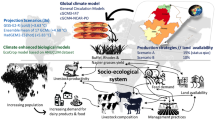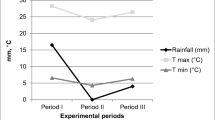Abstract
Among livestock systems, grazing is likely to be most impacted by climate change because of its dependency to feed quality and availability. In order to reduce the impact of climate change on grazing livestock systems, adaptation measures should be implemented. The goal of this study is to identify the best pasture composition for a representative grazing dairy farm in Michigan in order to reduce the impacts of climate change on production. In order to achieve the goal of this study, three objectives were sought: (1) identify the best pasture composition, (2) assess economic and resource use impacts of pasture compositions under future climate scenarios, and (3) evaluate the resiliency of pasture compositions. A representative farm was developed based on a livestock practices survey and incorporated into the Integrated Farm System Model (IFSM). For the pasture compositions, four cool-season grass species and two legumes were evaluated under both current and future climate scenarios. The effectiveness of adaptation measures based on economic and resource use criteria was evaluated. Overall, the pasture composition with 50% perennial ryegrass (Lolium multiflorum) and 50% red clover (Trifolium pratense) was identified as the best. In addition, the increase in precipitation and temperature of the most intensive climate scenario could significantly improve farm net return per cow (Bos taurus) and whole farm profit while no significant impact was observed on resource use criteria. Finally, the overall sensitivity assessment showed that the most resilient pasture composition under future climate scenarios was ryegrass with red clover and the least resilient was orchardgrass (Dactylis glomerata) with white clover (Trifolium repens).




Similar content being viewed by others
References
Adhikari U, Nejadhashemi AP, Woznicki SA (2015) Climate change and eastern Africa: a review of impact on major crops. Food Energy Secur 4:110–132
Aschmann S, Cropper JB (2007) Profitable grazing-based dairy systems. Range and pasture technical note no. 1, Natural Resources Conservation Service, U.S. Department of Agriculture
Baker TJ, Miller SN (2013) Using the soil and water assessment tool (SWAT) to assess land use impact on water resources in an east African watershed. J Hydrol 486:100–111
Barnes RF, Nelson CJ, Moore KJ, Collins M (2007) Forages: an introduction to grassland agriculture, 6th edn. Iowa State Press, A Blackwell Publishing Company, Ames
Batima P, Bat B, Tserendash L et al (2005) Adaptation to climate change. ADMON Publishing, Ulaanbaatar
Birhanu B, Ndomba P, Mtalo F (2007) Application of SWAT model for mountainous catchment. Catchment Lake Res 06:182–187
Bradley N (2007) The response surface methodology. Indiana University of South Bend
Bryant JR, Snow VO (2008) Modelling pastoral farm agro-ecosystems: a review. New Zeal J Agric Res 51:349–363
Calvosa C, Chuluunbaatar D, Fara K (2009) Livestock and climate change. Livest Themat Pap - Tools Proj Des 20
Cassida K, Paling J, Kapp C (2014) 2014 Michigan forage variety test report. Michigan State University Extension, Forage Factsheet #15–01. East Lansing, Michigan
Corson MS, Alan Rotz C, Howard Skinner R, Sanderson MA (2007) Adaptation and evaluation of the integrated farm system model to simulate temperate multiple-species pastures. Agric Syst 94:502–508
EPA (US Environmental Protection Agency) (2016) Climate change: basic information. In: Clim. Chang. Div. https://www3.epa.gov/climatechange/basics/. Cited 23 Feb 2016
FAO (Food and Agriculture Organisation of the United Nations) (2010) Climate-smart agriculture: policies, practices and financing for food security, adaptation and mitigation. Rome, Italy
FAO (Food and Agriculture Organization of the United Nations) (2009) Global agriculture towards 2050. Rome, Italy
FAO (Food and Agriculture Organization of the United Nations) (2016) Milk production. In: Dairy Prod. Prod. http://www.fao.org/agriculture/dairy-gateway/milk-production/en/#.VtCK0_krKUk. Cited 25 March 2016
Fisher R (1935) The design of experiments. Oliver and Boyd, Edinburgh
Garnett T (2009) Livestock-related greenhouse gas emissions: impacts and options for policy makers. Environ Sci Pol 12:491–503
Gauly M, Bollwein H, Breves G et al (2013) Future consequences and challenges for dairy cow production systems arising from climate change in Central Europe—a review. Animal 7:843–859
Graux AI, Bellocchi G, Lardy R, Soussana JF (2013) Ensemble modelling of climate change risks and opportunities for managed grasslands in France. Agric For Meteorol 170:114–131
Griffin TS (2004) Growing forage legumes in Maine. In: Bull. #2261, Univ. Maine Coop. Ext. http://umaine.edu/publications/2261e/. Cited 16 March 2016
Hatfield J, Takle G, Grotjahn R, Holden P, Izaurralde RC, Mader T, Marshall E, Liverman D (2014) Ch. 6: Agriculture. Climate change impacts in the United States: The Third National Climate Assessment, Melillo JM, Richmond TC, Yohe GW (Eds.), U.S. Global Change Research Program, 150–174
Heckman E, Hinds S, Johnson K, Perkins J (2007) Management-intensive grazing in Indiana. Indiana, U.S
Heinrichs AJ, Ishler VA, Adams RS (1996) Feeding and managing dry cows. Extension circular 372. The Pennsylvania State University, Pennsylvania
Herrero M, Thornton PK, Notenbaert A, et al. (2012) Drivers of change in crop-livestock systems and their potential impacts on agro-ecosystems services and human wellbeing to 2030. A study Comm by CGIAR Syst Livest Program Nairobi, Kenya ILRI 1–114
Hoglind M, Thorsen SM, Semenov MA (2013) Assessing uncertainties in impact of climate change on grass production in northern Europe using ensembles of global climate models. Agric For Meteorol 170:103–113
IPCC (Intergovernmental Panel on Climate Change) (2013) Climate change 2013: The physical science basis. Contribution of Working Group I to the Fifth Assessment Report of the Intergovernmental Panel on Climate Change. Cambridge, United Kingdom and New York, USA
IPCC (Intergovernmental Panel on Climate Change) (2014) Climate change 2014: impacts, adaptation, and vulnerability. Part a: global and Sectoral aspects. In: Field CB, Barros VR, Dokken DJ, Mach KJ, Mastrandrea MD, Bilir TE, Chatterjee M, Ebi KL, Estrada YO, Genova RC, Girma B, Kissel ES, Levy AN, MacCracken S, Mastrandrea PR, White LL (eds) Contribution of working group II to the fifth assessment report of the intergovernmental panel on climate change. Cambridge University Press, Cambridge 1132 pp.
Ishler V, Heinrichs J, Varga G (1996) From feed to milk: understanding rumen function. Extension circular 422. The Pennsylvania State University, Pennsylvania
Jeong J, Williams JR, Rossi CG et al (2015) Development of the spatial rainfall generator (SRGEN) for the agricultural policy/environmental extender model. JAWRA J Am Water Resour Assoc 51:154–167
Kalaugher E, Bornman JF, Clark A, Beukes P (2013) An integrated biophysical and socio-economic framework for analysis of climate change adaptation strategies: the case of a New Zealand dairy farming system. Environ Model Softw 39:176–187
Kriegl T, McNair R (2005) Pastures of plenty: financial performance of Wisconsin grazing dairy farms. University of Wisconsin-Madison, Madison
Kurukulasuriya P, Rosenthal S (2003) Climate change and agriculture: a review of impacts and adaptations. Clim. Chang. Ser. Pap. No. 91, World Bank, Washington, DC
Lacefield G (2013) Red and white clover. University of Kentucky Cooperative Extension Service, Kentucky
Luo Y, Zhang M (2009) Management-oriented sensitivity analysis for pesticide transport in watershed-scale water quality modeling using SWAT. Environ Pollut 157:3370–3378
MacFarlane AW (1990) Field experience with new pasture cultivars in Canterbury. Proc New Zeal Grassl Assoc 52:139–143
Melillo JM, Richmond T, Yohe GW (2014) Climate change impacts in the United States: The Third National Climate Assessment. U.S. Global Change Research Program
Moore AD, Ghahramani A (2013) Climate change and broadacre livestock production across southern Australia. 1. Impacts of climate change on pasture and livestock productivity, and on sustainable levels of profitability. Glob Chang Biol 19:1440–1455
Nardone A, Ronchi B, Lacetera N et al (2010) Effects of climate changes on animal production and sustainability of livestock systems. Livest Sci 130:57–69
Nejadhashemi AP, Wardynski BJ, Munoz JD (2012) Large-scale hydrologic modeling of the Michigan and Wisconsin agricultural regions to study impacts of land use changes. Trans ASABE 55:821–838
Nott S (2003) Evolution of dairy grazing in the 1990’s. Department of Agricultural Economics Staff Paper No. 2003–07, Michigan State University, East Lansing, Michigan
Oweis TY (2008) Improving agricultural water productivity: a necessary response to water scarcity and climate change in dry areas. In: Rowlinson P, Steele M, Nefzaoui A (eds) Proceedings of livestock and global change, an international conference, Hammamet, Tunisia, 17–20 May 2008
PCMDI (Program for Climate Model Diagnosis and Intercomparison) (2015) CMIP5 coupled model intercomparison project. In: WCRP (World Clim. Res. Program. http://cmip-pcmdi.llnl.gov/cmip5/availability.html. Cited 12 Jan 2016
Polley HW, Briske DD, Morgan JA et al (2013) Climate change and north American rangelands: trends, projections, and implications. Rangel Ecol Manag 66:493–511
Rayburn EB (2007) Forage utilization for pasture-based livestock production. Natural Resource, Agriculture, and Engineering Service (NRAES), New York
Rayburn EB (2008) Animal production systems for pasture-based livestock production. Natural Resource, Agriculture, and Engineering Service (NRAES), New York
Rojas-Downing MM (2013) Resource use and conservation and environmental impacts in the transition from confinement to pasture-based dairies. M.Sc. Thesis, Michigan State University
Rotz CA (2004) The integrated farm system model: a tool for developing more economically and environmentally sustainable farming systems for the Northeast. In: NABEC. 2004 Northeast Agricultural and Biological Engineering Conference Sponsored by ASAE, pp 4–22
Rotz CA, Corson MS, Chianese DS, et al. (2014) The integrated farm system model - Reference Manual - Version 4.2. Pasture systems and watershed management research unit, Agricultural Research Service, United States Department of Agriculture
Rowlinson P (2008) Adapting livestock production systems to climate change: temperate zones. In: Rowlinson P, Steel M, Nefzaoui A (eds) Livestock and global change. Cambridge University Press, Cambridge, pp 61–63
Shrestha S, Abdalla M, Hennessy T et al (2015) Irish farms under climate change—is there a regional variation on farm responses? J Agric Sci 153:385–398
Sullivan K, DeClue R, Emmick D (2000) Prescribed grazing and feeding management for lactating dairy cows. USDA-NRCS, Syracuse
Thornton PK, van de Steeg J, Notenbaert A, Herrero M (2009) The impacts of climate change on livestock and livestock systems in developing countries: a review of what we know and what we need to know. Agric Syst 101:113–127
Thrasher B, Maurer EP, McKellar C, Duffy PB (2012) Technical note: bias correcting climate model simulated daily temperature extremes with quantile mapping. Hydrol Earth Syst Sci 16:3309–3314
United Dairy Industry of Michigan (2016) Dairy Facts. http://www.milkmeansmore.org/print/36. Cited 02 April 2016
USDA NASS (2014a) 2012 Census of agriculture—Michigan State and County Data
USDA NASS (2014b) Cropland data layer. In: Michigan Pasturel. https://nassgeodata.gmu.edu/CropScape/. Cited 18 Oct 2015
USDA NASS (2014c) Milk cows and production: final estimates 2008–2012. http://usda.mannlib.cornell.edu/usda/nass/milkcowest//2010s/2014/milkcowest_Milk Cows and Production - Final Estimates, 2008–12.pdf. Cited 05 April 2016
USDA-ARS (United States Department of Agriculture- Agricultural Research Service) (2014) Integrated farm system model. In: Pasture Syst. Watershed Mgt. Res. Unit. http://www.ars.usda.gov/Main/docs.htm?docid=8519. Cited 29 Oct 2015
Wachendorf M, Golinski P (2006) Towards sustainable intensive dairy farming in Europe. Grassl Sci Eur 11:159–174
Wallis TWR, Griffiths JF (1995) An assessment of the weather generator (WXGEN) used in the erosion/productivity impact calculator (EPIC). Agric For Meteorol 73:115–133
Wilson T (2007) Perceptions, practices, principles and policies in provision of livestock–water in Africa. Agr Water Manage 90:1–12
Woznicki SA, Nejadhashemi AP (2012) Sensitivity analysis of best management practices under climate change scenarios. JAWRA J Am Water Resour Assoc 48:90–112
Woznicki SA, Pouyan Nejadhashemi A (2014) Assessing uncertainty in best management practice effectiveness under future climate scenarios. Hydrol Process 28:2550–2566
Acknowledgments
This work is supported by the US Department of Agriculture - National Institute of Food and Agriculture, Hatch project MICL02359.
Author information
Authors and Affiliations
Corresponding author
Electronic supplementary material
.
ESM 1
(DOCX 7358 kb)
Rights and permissions
About this article
Cite this article
Rojas-Downing, M.M., Nejadhashemi, A.P., Abouali, M. et al. Pasture diversification to combat climate change impacts on grazing dairy production. Mitig Adapt Strateg Glob Change 23, 405–431 (2018). https://doi.org/10.1007/s11027-017-9740-5
Received:
Accepted:
Published:
Issue Date:
DOI: https://doi.org/10.1007/s11027-017-9740-5




